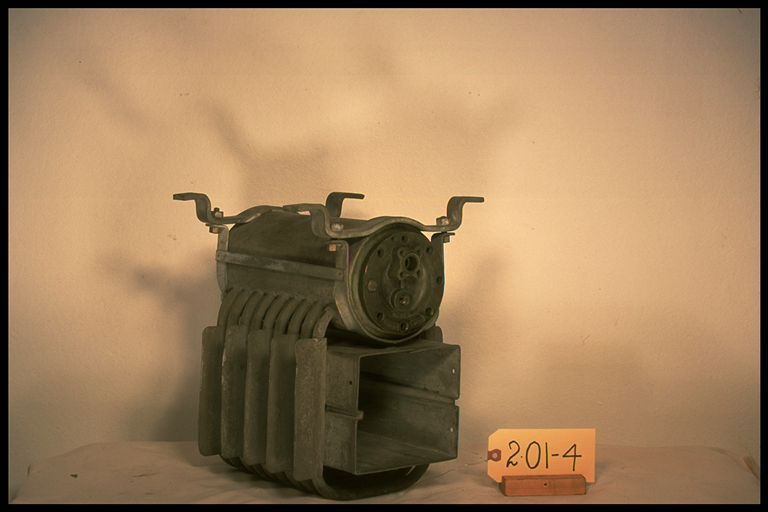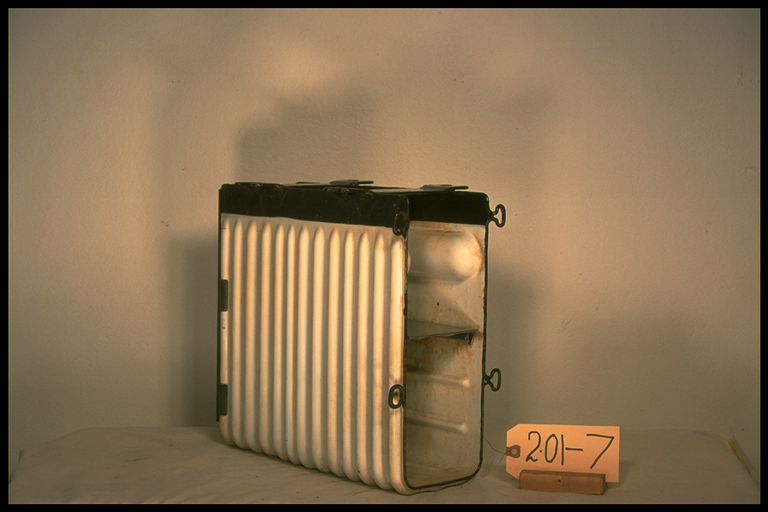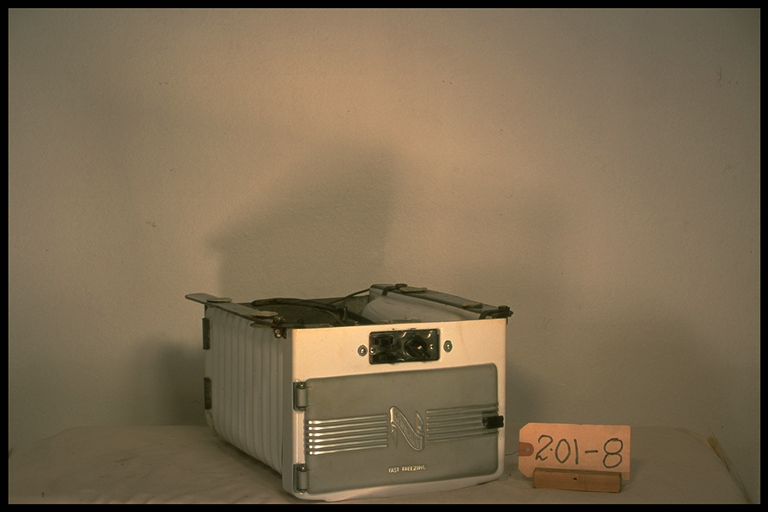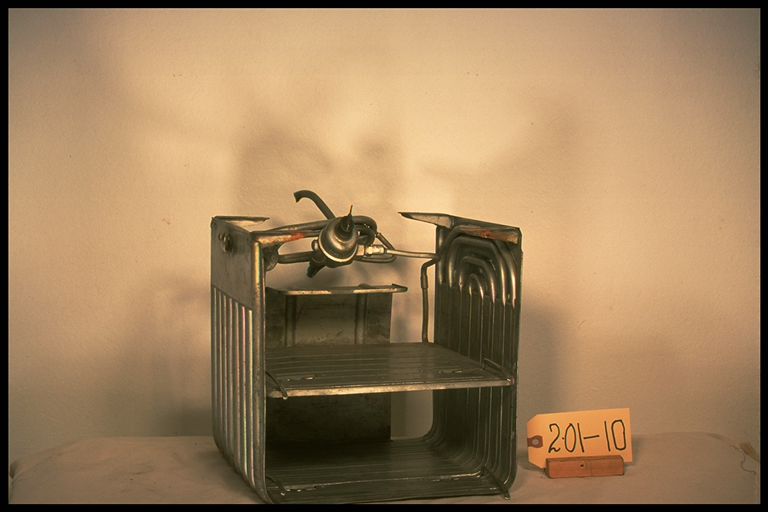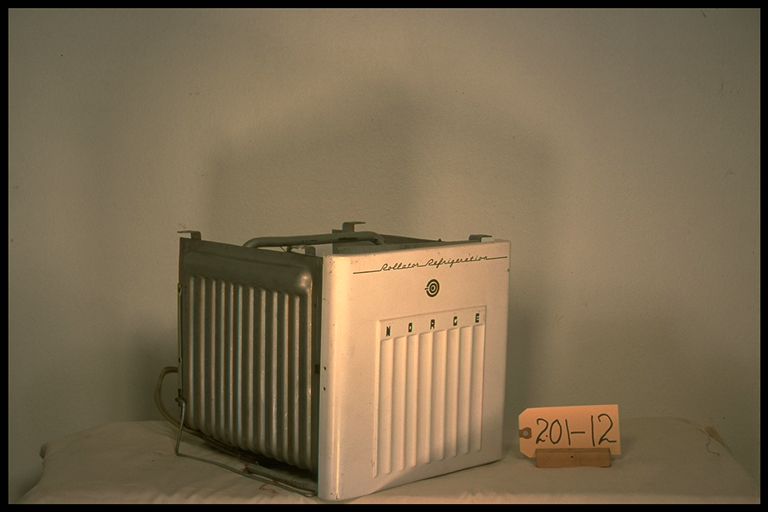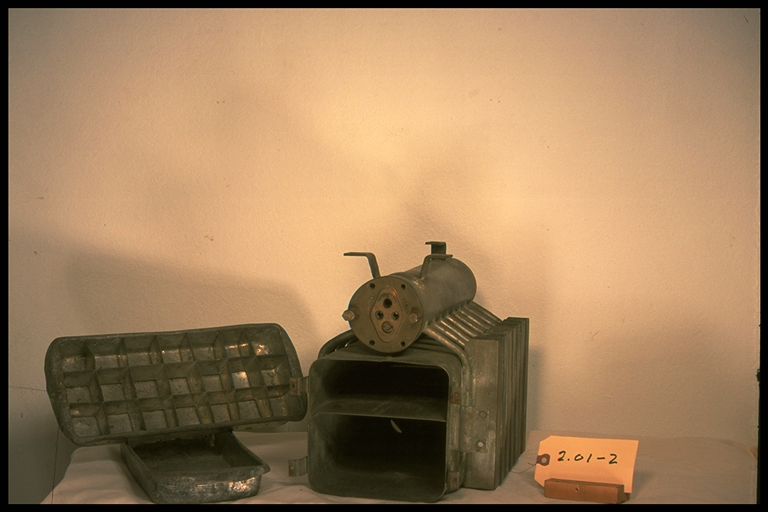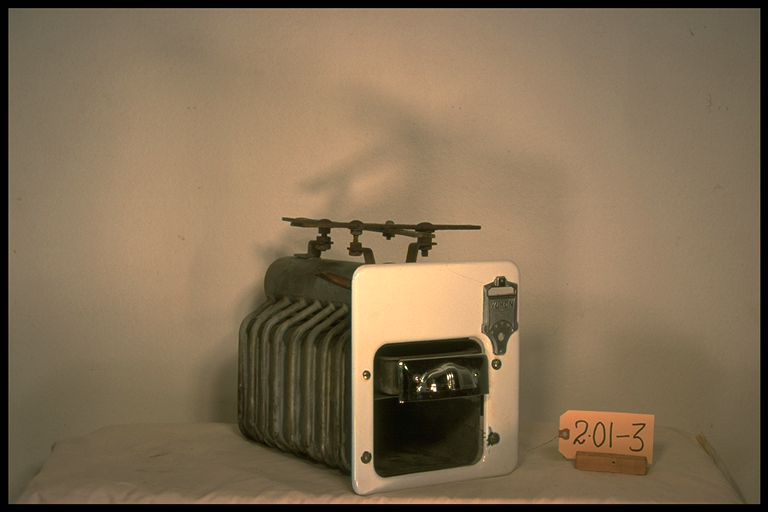2.01-5: Norge 1936 Two Tray Cooling Unit for Cabinet Refrigerator
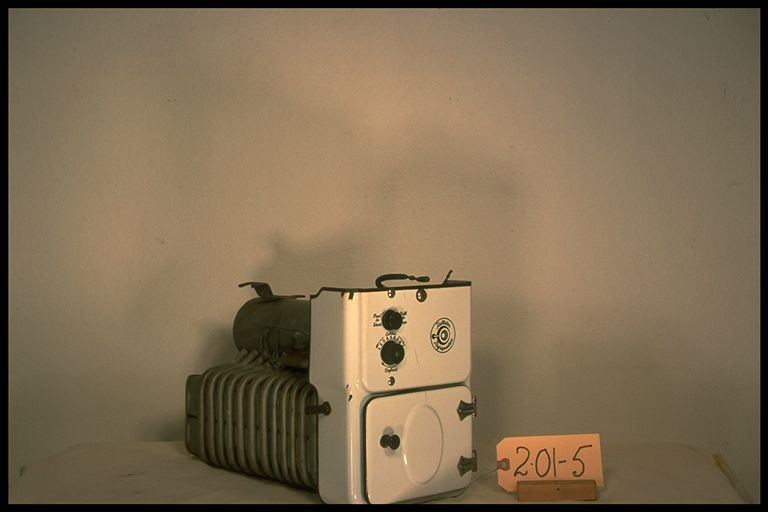
| HHCC Accession No. 2003.014 | HHCC Classification Code: 2.01-5 |
|---|
Description:
Two tray, flooded evaporator with low-side float, modern, formed front plate and hinged door in white porcelain, decorated with black trim and built in temperature control mount; cooling unit for Norge household cabinet refrigerator, Norge, 1936.
Group:
2.01 Refrigerating and Air Conditioning Evaporators - Household
Make:
Norge
Manufacturer:
Borg Warner Corp. Michigan
Model:
unknown
Serial No.:
unknown
Size:
7x 14x 10’
Weight:
5 lbs
Circa:
1936
Rating:
Exhibition Quality, a rare example of the work of a market leader in the styling and modernisation of the household refrigerator
Patent Date/Number:
Provenance:
From York County (York Region) Ontario, once a rich agricultural hinterlands, attracting early settlement in the last years of the 18th century. Located on the north slopes of the Oak Ridges Moraine, within 20 miles of Toronto, the County would also attract early ex-urban development, to be come a wealthy market place for the emerging household and consumer technologies of the early and mid 20th century.
This artifact was discovered in the 1950’s in the used stock of T. H. Oliver, Refrigeration and Electric Sales and Service, Aurora, Ontario, an early worker in the field of agricultural, industrial and consumer technology.
Type and Design:
Two tray, flooded evaporator in tinned, heavy copper plate, with float chamber, float assembly, and needle valve calibrated for S02 refrigerant; 12 pass 3/8 copper coil distributing tubes, with formed front plate and door in porcelain and front mounted temperature control
Construction:
The smoothly crafted configuration is indicative of a new generation of engineering and manufacturing.
Material:
Special Features:
Styled with modern curved line and form, this cooling unit reflects the Art Deco influences of the mid 1930’s. Of special note is the built in temperature control and on-off switch, conveniently place for the homemaker. The control is equipped with a manual, reset overload switch by Ranco, a leading innovation in control technology for the times
Accessories:
Capacities:
Performance Characteristics:
Operation:
Control and Regulation:
Targeted Market Segment:
Consumer Acceptance:
Merchandising:
With a fresh new look and with a decade of engineering, manufacturing and marketing experience to build on, the marketing appeal was to a second generation of buyers, They were those with new expectations and life style interests to be appeased and with the money to appease them. Many, too, would be first time buyers, reflecting increasing affluence of middle class Canada, now moving into increasingly urban locations and life styles.
Market Price:
Technological Significance:
The technological significance of the evaporator in a mechanical refrigeration system lies in its ability to evaporate liquid refrigerant (allowing it to absorb latent heat and thus perform useful cooling). In the public mind, however, the useful work was more simply that of cooling.
This lead astute manufactures to popularise the use of the term ‘cooling unit’ in place of evaporator. It was the term adopted by the industry in the early years, as it attempted to connect with the human experience of the times to better promote its wares, gaining market share in the embryonic years of Canada’s emerging consumer society. (See examples in early sale literature from the Kelvinator Co. of Canada)
Human experience and the social culture of the 1920’s also associated useful cooling with the melting of ice. Historically manufactures successfully played to this sense of public understanding by further marketing cooling units as icemakers. By this means they appealed to wide spread cultural understandings of how things got cooled, through the controlled melting of ice (the popular Canadian icebox of the 1920’s and 30’s). In a peculiar twist, it was often the job of the refrigeration sales or service man to explain to the homemaker that it was not really the ice in the ice cube trays that cooled the refrigerator, but the motor and compressor underneath.
In the 1920’s manufactures of mechanical refrigerators for the home appealed to the consumer public by promoting ice and ice cream as the new consumables, the new food sensations available for all those sufficiently affluent to enjoy the experience. Promotional literature focused on the pleasant sensation of ice cold beverages and on ice cream making at home ‘ using the latest cooling unit. A recipe and food life style book came with the refrigerator for the edification and instruction of the homemaker (See examples in early sale literature from the Kelvinator Co. of Canada). Ice and ice cream making in the home was, in fact, one of the significant, new ‘Gee whiz’, household technologies of the times.
This specimen is a remarkable icon of its time, marking a dramatic change in engineering, manufacturing and styling, as the industry geared up to move beyond its embryonic development years. Of particular note, technically, is the inclusion of an automatic overload device, with manual reset. This was representative of the early years of safety control technology designed for equipment protection and personal safety.
Industrial Significance:
With the mid 1930’s came increased competition in the refrigeration appliance field, as companies such as Borg Warner and General Motors/Frigidaire, with significant engineering and production experience and resources behind them made major investments in the now rapidly expanding field.
Socio-economic Significance:
The closed back, and tightly fitting door on this cooling unit are significant developments in them selves. They were new for the time, as manufactured attempted to respond to public interest in lower freezer temperatures for holding ice cream and other frozen foods products.
Socio-cultural Significance:
Donor:
G. Leslie Oliver, The T. H. Oliver HVACR Collection
HHCC Storage Location:
Tracking:
Bibliographic References:
See Norge Rollator Refrigeration Service, Open Type Systems
Notes:
Note #1 Norge show this model, manufactured by Borg Warner, replacing an earlier design by Fedders, as in use between 1933 and 1938, see manual
